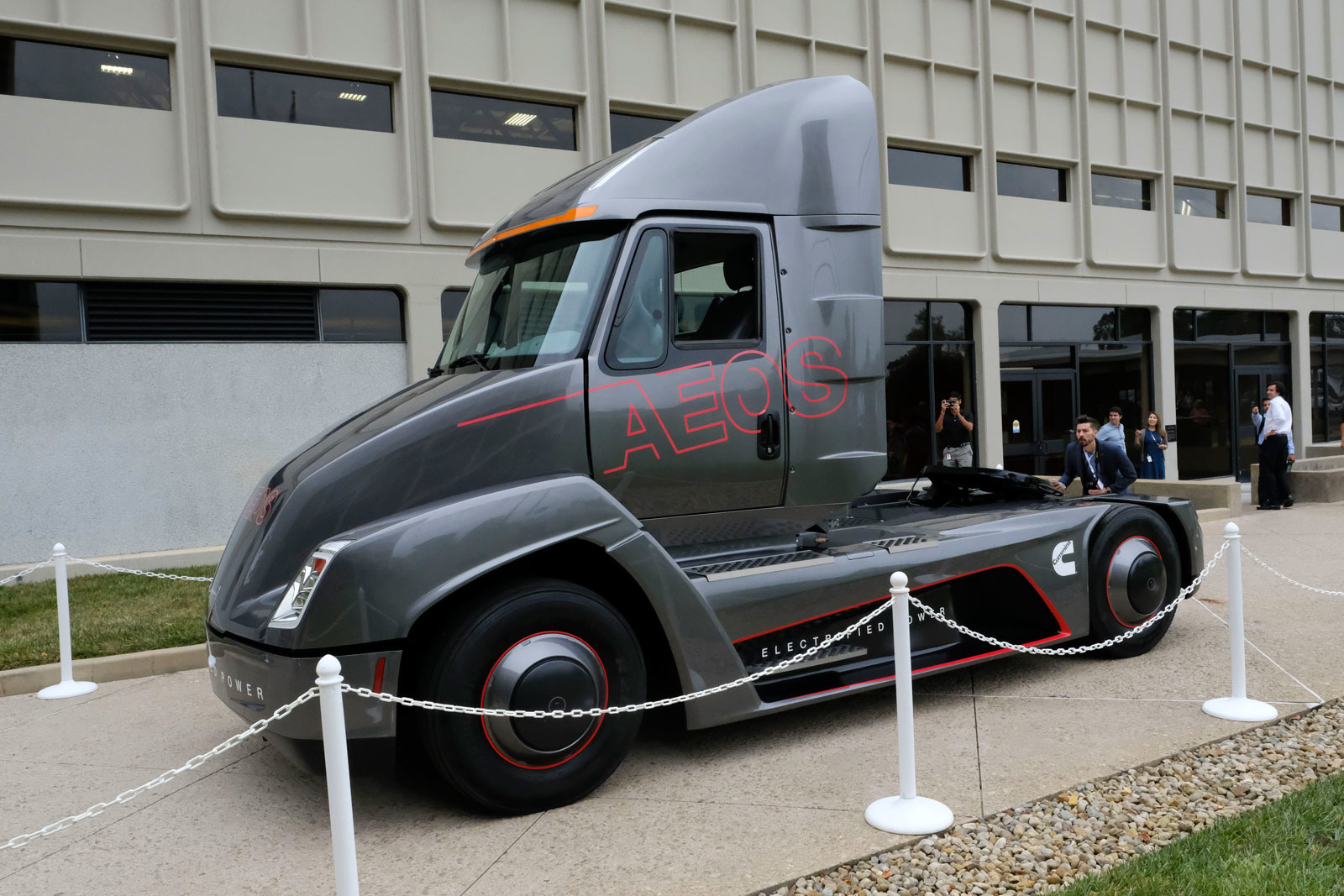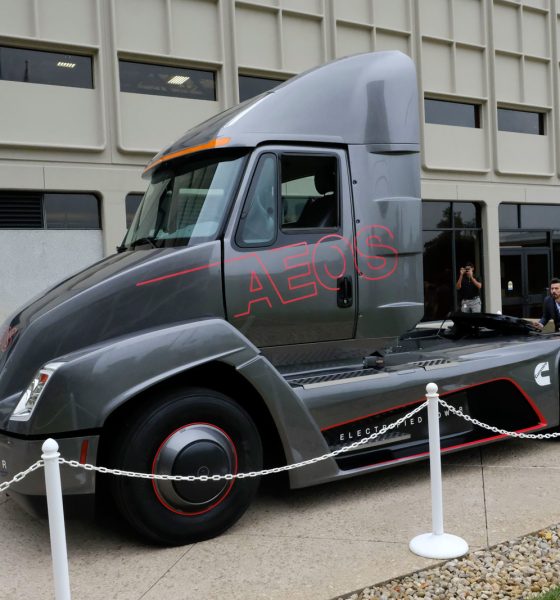

News
Tesla Semi competition with 140 kWh battery emerges before reveal event, Tesla co-founder weighs in
This Article first appeared on:
Less than a month away from the Tesla Semi reveal event, competitors are emerging to challenge the Elon Musk-led company on its first foray into the commercial trucking sector. After witnessing Tesla’s wildly successful entrance into the passenger vehicle space, existing players in the trucking industry have already realized the potential disruption Tesla could bring in their own backyard.
Just yesterday, Cummins, a massive $27 billion truck manufacturer, announced they have built an electric truck that they plan to mass produce in the next two years. The electric truck carries a 140 kWh battery pack and fast-charging technology. The 140 kWh pack will allow the vehicle to travel up to 100 miles on a single charge and capable of recharging to full capacity in approximately one hour. Cummins also plans to include a range extender to raise the overall range to 300 miles. Similar to Tesla who recently announced that their all-electric truck will have between 200 to 300 miles of range, Cummins is mainly targeting short-haul trucking needs.
Tesla CEO Elon Musk first shared his plans in July 2016 when he announced the company’s plans to shake the trucking industry to its roots. And it was revealed earlier this month that Tesla has begun testing “platooning” technology to increase battery range. Platooning would allow the trucks to drive autonomously and close together to reduce aerodynamic drag.
But in order for platooning to work effectively, the trucks must be able to safely navigate the dense interstates in close proximity, with little to no risk towards other vehicles. Like most things, that is easier said than done. To understand the feasibility of platooning and electric heavy duty trucks, we spoke to one of the leaders in the industry, Wrightspeed.
If Wrightspeed sounds familiar, its probably because you’ve heard of its founder, Ian Wright. Ian was one of the co-founders of Tesla in 2003 and left the company in 2005 to pursue the commercial vehicle industry. Since then, Wrightspeed has designed and manufactured several different hybrid electric powertrains for buses, garbage trucks, and delivery vehicles.
Forget Platooning, Road-Trains are Coming
Here’s what Ian Wright had to say about Platooning and how he plans to tackle this issue.
“Why don’t you pull two of three trailers with one tractor, that would be a lot more efficient than platooning.” – Ian Wright, CEO and Founder of Wrightspeed.
 While Wrightspeed isn’t ready to start producing a powertrain for a hybrid electric truck, they are looking at the market seriously. The company believes that in order to maximize savings for trucking operators, their still needs to be a range extender in trucks, at least until batteries are more dense. You can listen to the full interview with Ian Wright in Episode 2 on September 13th on the NextMobility podcast.
While Wrightspeed isn’t ready to start producing a powertrain for a hybrid electric truck, they are looking at the market seriously. The company believes that in order to maximize savings for trucking operators, their still needs to be a range extender in trucks, at least until batteries are more dense. You can listen to the full interview with Ian Wright in Episode 2 on September 13th on the NextMobility podcast.
The first episode premieres next Wednesday.
To stay on top of the latest developments in AI and autonomous technology, with special guests from industry experts, be sure to subscribe to the NextMobility podcast available on iTunes.

Elon Musk
Elon Musk and Tesla AI Director share insights after empty driver seat Robotaxi rides
The executives’ unoccupied tests hint at the rapid progress of Tesla’s unsupervised Robotaxi efforts.

Tesla CEO Elon Musk and AI Director Ashok Elluswamy celebrated Christmas Eve by sharing personal experiences with Robotaxi vehicles that had no safety monitor or occupant in the driver’s seat. Musk described the system’s “perfect driving” around Austin, while Elluswamy posted video from the back seat, calling it “an amazing experience.”
The executives’ unoccupied tests hint at the rapid progress of Tesla’s unsupervised Robotaxi efforts.
Elon and Ashok’s firsthand Robotaxi insights
Prior to Musk and the Tesla AI Director’s posts, sightings of unmanned Teslas navigating public roads were widely shared on social media. One such vehicle was spotted in Austin, Texas, which Elon Musk acknowleged by stating that “Testing is underway with no occupants in the car.”
Based on his Christmas Eve post, Musk seemed to have tested an unmanned Tesla himself. “A Tesla with no safety monitor in the car and me sitting in the passenger seat took me all around Austin on Sunday with perfect driving,” Musk wrote in his post.
Elluswamy responded with a 2-minute video showing himself in the rear of an unmanned Tesla. The video featured the vehicle’s empty front seats, as well as its smooth handling through real-world traffic. He captioned his video with the words, “It’s an amazing experience!”
Towards Unsupervised operations
During an xAI Hackathon earlier this month, Elon Musk mentioned that Tesla owed be removing Safety Monitors from its Robotaxis in Austin in just three weeks. “Unsupervised is pretty much solved at this point. So there will be Tesla Robotaxis operating in Austin with no one in them. Not even anyone in the passenger seat in about three weeks,” he said. Musk echoed similar estimates at the 2025 Annual Shareholder Meeting and the Q3 2025 earnings call.
Considering the insights that were posted Musk and Elluswamy, it does appear that Tesla is working hard towards operating its Robotaxis with no safety monitors. This is quite impressive considering that the service was launched just earlier this year.
Elon Musk
Starlink passes 9 million active customers just weeks after hitting 8 million
The milestone highlights the accelerating growth of Starlink, which has now been adding over 20,000 new users per day.

SpaceX’s Starlink satellite internet service has continued its rapid global expansion, surpassing 9 million active customers just weeks after crossing the 8 million mark.
The milestone highlights the accelerating growth of Starlink, which has now been adding over 20,000 new users per day.
9 million customers
In a post on X, SpaceX stated that Starlink now serves over 9 million active users across 155 countries, territories, and markets. The company reached 8 million customers in early November, meaning it added roughly 1 million subscribers in under seven weeks, or about 21,275 new users on average per day.
“Starlink is connecting more than 9M active customers with high-speed internet across 155 countries, territories, and many other markets,” Starlink wrote in a post on its official X account. SpaceX President Gwynne Shotwell also celebrated the milestone on X. “A huge thank you to all of our customers and congrats to the Starlink team for such an incredible product,” she wrote.
That growth rate reflects both rising demand for broadband in underserved regions and Starlink’s expanding satellite constellation, which now includes more than 9,000 low-Earth-orbit satellites designed to deliver high-speed, low-latency internet worldwide.
Starlink’s momentum
Starlink’s momentum has been building up. SpaceX reported 4.6 million Starlink customers in December 2024, followed by 7 million by August 2025, and 8 million customers in November. Independent data also suggests Starlink usage is rising sharply, with Cloudflare reporting that global web traffic from Starlink users more than doubled in 2025, as noted in an Insider report.
Starlink’s momentum is increasingly tied to SpaceX’s broader financial outlook. Elon Musk has said the satellite network is “by far” the company’s largest revenue driver, and reports suggest SpaceX may be positioning itself for an initial public offering as soon as next year, with valuations estimated as high as $1.5 trillion. Musk has also suggested in the past that Starlink could have its own IPO in the future.
News
NVIDIA Director of Robotics: Tesla FSD v14 is the first AI to pass the “Physical Turing Test”
After testing FSD v14, Fan stated that his experience with FSD felt magical at first, but it soon started to feel like a routine.

NVIDIA Director of Robotics Jim Fan has praised Tesla’s Full Self-Driving (Supervised) v14 as the first AI to pass what he described as a “Physical Turing Test.”
After testing FSD v14, Fan stated that his experience with FSD felt magical at first, but it soon started to feel like a routine. And just like smartphones today, removing it now would “actively hurt.”
Jim Fan’s hands-on FSD v14 impressions
Fan, a leading researcher in embodied AI who is currently solving Physical AI at NVIDIA and spearheading the company’s Project GR00T initiative, noted that he actually was late to the Tesla game. He was, however, one of the first to try out FSD v14.
“I was very late to own a Tesla but among the earliest to try out FSD v14. It’s perhaps the first time I experience an AI that passes the Physical Turing Test: after a long day at work, you press a button, lay back, and couldn’t tell if a neural net or a human drove you home,” Fan wrote in a post on X.
Fan added: “Despite knowing exactly how robot learning works, I still find it magical watching the steering wheel turn by itself. First it feels surreal, next it becomes routine. Then, like the smartphone, taking it away actively hurts. This is how humanity gets rewired and glued to god-like technologies.”
The Physical Turing Test
The original Turing Test was conceived by Alan Turing in 1950, and it was aimed at determining if a machine could exhibit behavior that is equivalent to or indistinguishable from a human. By focusing on text-based conversations, the original Turing Test set a high bar for natural language processing and machine learning.
This test has been passed by today’s large language models. However, the capability to converse in a humanlike manner is a completely different challenge from performing real-world problem-solving or physical interactions. Thus, Fan introduced the Physical Turing Test, which challenges AI systems to demonstrate intelligence through physical actions.
Based on Fan’s comments, Tesla has demonstrated these intelligent physical actions with FSD v14. Elon Musk agreed with the NVIDIA executive, stating in a post on X that with FSD v14, “you can sense the sentience maturing.” Musk also praised Tesla AI, calling it the best “real-world AI” today.










